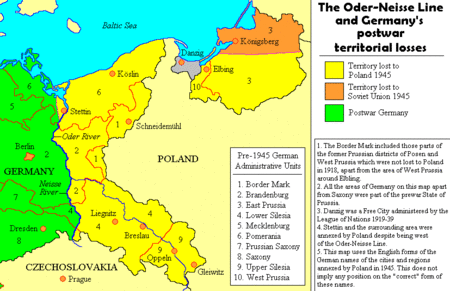Oder–Neisse line

The Oder–Neisse line (German: Oder-Neiße-Grenze, Polish: granica na Odrze i Nysie Łużyckiej) is an unofficial term for the modern border between Germany and Poland. The line generally follows the Oder and Lusatian Neisse rivers, meeting the Baltic Sea in the north. A small portion of Polish territory does fall west of the line, including the cities of Szczecin and Świnoujście (German: Stettin and Swinemünde).All prewar German territories east of the line and within the 1937 German boundaries – comprising nearly one quarter (23.8 percent) of the Weimar Republic – were ceded under the changes decided at the Potsdam Conference, with the majority ceded to Poland. The remainder, consisting of northern East Prussia including the German city of Königsberg (renamed Kaliningrad), was allocated to the Soviet Union, as the Kaliningrad Oblast of the Russian SFSR (today Russia). Much of the German population in these territories – estimated at around 12 million in autumn 1944 – had fled in the wake of the Soviet Red Army's advance. The Oder–Neisse line marked the border between East Germany and Poland from 1950 to 1990. The two Communist governments agreed to the border in 1950, while West Germany, after a period of refusal, adhered to the border, with reservations, in 1972 (treaty signed with Poland in 1970).After the revolutions of 1989, newly reunified Germany and Poland accepted the line as their border in the 1990 German–Polish Border Treaty.
Excerpt from the Wikipedia article Oder–Neisse line (License: CC BY-SA 3.0, Authors, Images).Oder–Neisse line
Dünenstraße, Heringsdorf
Geographical coordinates (GPS) Address Nearby Places Show on map
Geographical coordinates (GPS)
| Latitude | Longitude |
|---|---|
| N 53.926305555556 ° | E 14.224027777778 ° |
Address
Dünenstraße
17419 Heringsdorf
Mecklenburg-Vorpommern, Germany
Open on Google Maps










